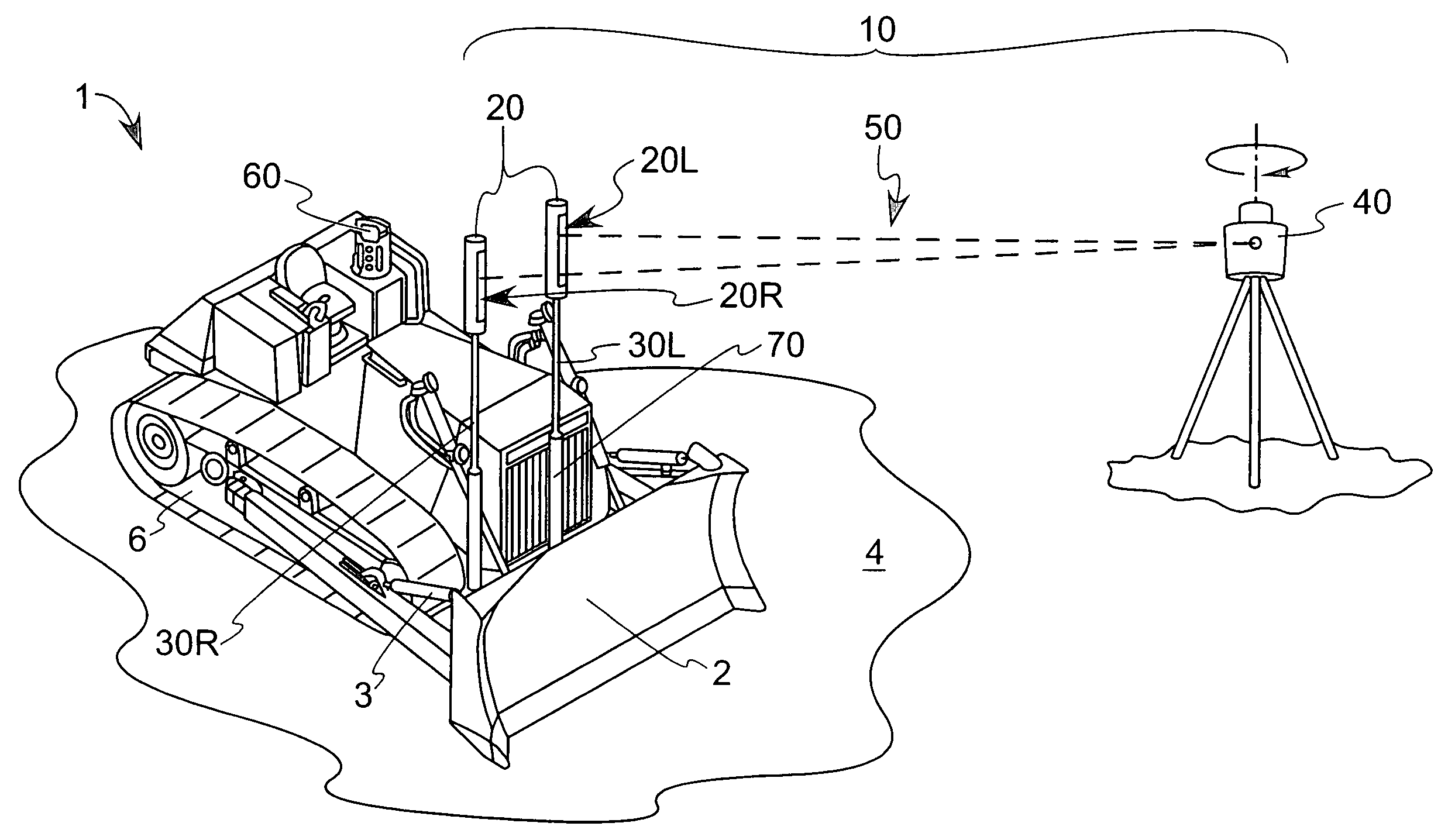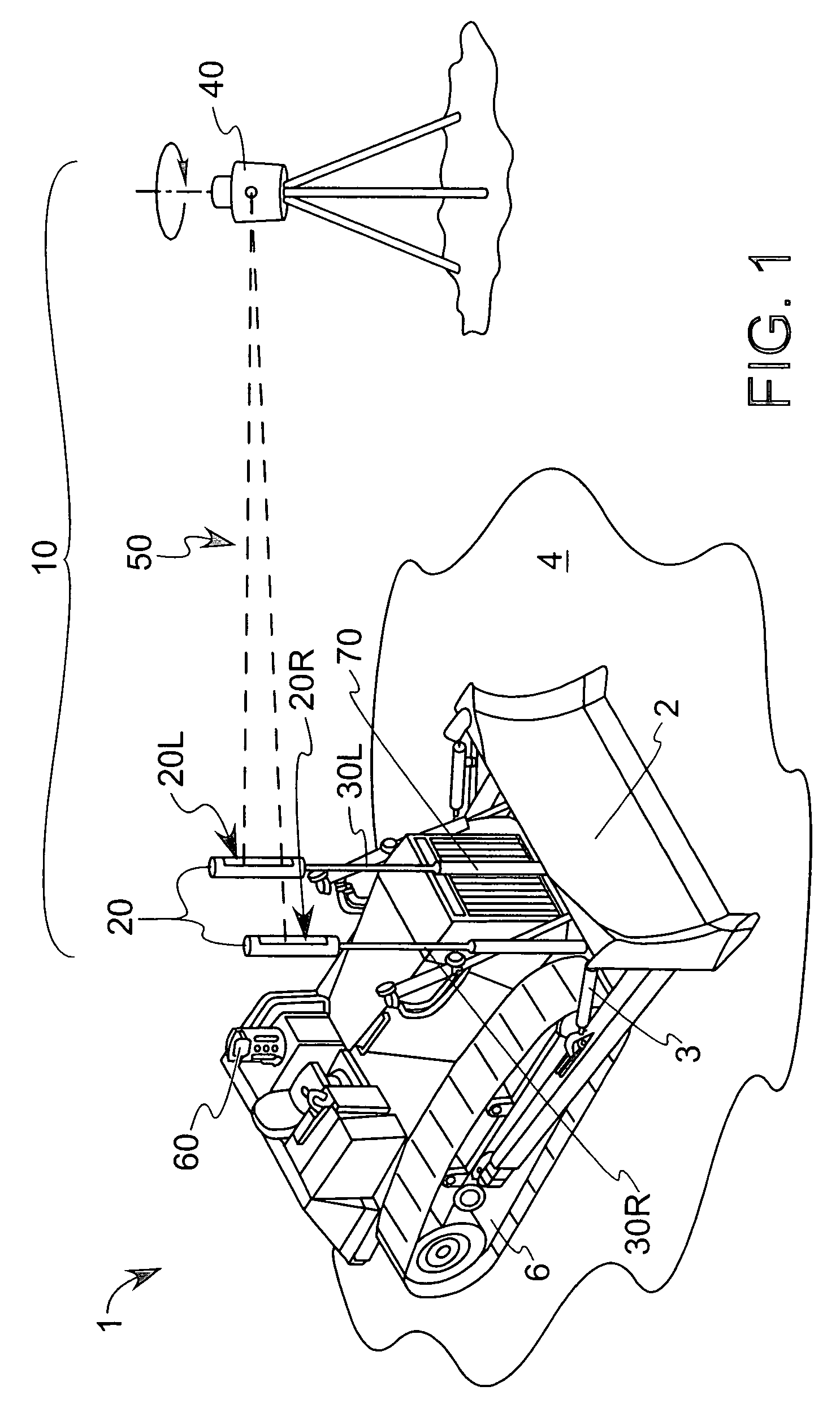[0007] In the present context, the term “substantially” refers to an arrangement of elements or features that, while in theory would be expected to exhibit exact correspondence or behavior, may, in practice embody something less than exact. As such, the term denotes the degree by which a quantitative value, measurement or other related representation may vary from a stated reference without resulting in a change in the basic function of the
subject matter at issue. The controller includes at least one user-operable input mechanism to facilitate manual
actuator operation and an
information processor to facilitate the automatic operation of the actuators. The device also includes an output configured to display information pertaining to a position of the blade, such as its elevation. Optionally, the output is configured to display a single blade position value. The
system may further include a
laser guidance apparatus with a
signal source configured to provide a reference
signal to the controller and a plurality of detectors configured to be in
signal communication with the source and the controller. This allows that in either manual or automatic operation, the actuators can move the blade in response to a difference between the detected reference signal and the blade position.
[0008] According to another aspect of the present invention, a control system for a
machine tool includes a plurality of actuators configured to move the tool, and a guidance apparatus configured to control the actuators. The guidance apparatus includes a
signal source, a plurality of detectors configured to be signally coupled to the source, and a controller configured to operate in more than one operational mode. In the present context, the detectors and source are considered to be signally coupled to one another as long as the signal emanating from the source is sensed by the signal-sensing portion of the
detector. The detectors are connected to the
machine tool, either at opposing ends, one at the end with one at the center, or in any other spaced relationship across the tool, depending on the tool configuration. The controller is made up of at least a
data interface coupled to the detectors, at least one user-operable input mechanism, an
information processor responsive to the input mechanism and an output configured to display information in either of the plurality of operational
modes. When the controller is in a first of the plurality of operational
modes, each of the actuators is driven by the controller independently of the other actuators. When in a second operational mode, the plurality of actuators are responsively linked such that they are driven in
unison with one another. This is beneficial in that even when at least one of the detectors is no longer signally coupled to the source, the relative position between the ends (or end and center) of the tool remain fixed, thereby avoiding erroneous tool settings. An additional benefit arises in that an operator need only refer to a single tool position displayed on the output when adjustments to the tool position are necessary.
[0014] Optionally, a mast is coupled to each of the detectors and configured to move the detectors to facilitate signal communication between the
detector and the
signal source. By way of example, the masts can be movable, and also include motors to translate the corresponding detectors. As previously discussed, in a linked mode of operation, movement of particular components (such as blade actuators, or masts to move the detectors, for example) are responsively linked such that they are driven in unison with one another. By requiring only one
control point to be input during the benching process, the linked mode simplifies user operation and promotes consistent, accurate apparatus setup. The method includes the steps of providing a benchmark at a location accessible to the blade, positioning the blade substantially on the benchmark, transmitting a signal with the source, inputting instructions into the input mechanism and receiving the signal with at least one of the detectors until a
setpoint is established by at least one of the detectors. In configurations where masts are employed, the detectors can be moved until at least one of them is substantially aligned with the signal to define a substantially on-grade position. In the linked mode of operation, the masts can extend or retract in response to operator input (such as an offset command). Upon
receipt of the command, the masts move the detectors until the detectors comply with the input command. In another option, it is the portion of the blade that is substantially underneath one of the detectors that is positioned substantially on the benchmark. As previously described, this portion of the blade corresponds to a particular location that coincides with the placement of the masts and detectors above it, including the blade center, right side or left side. In linked mode, the user inputs are simplified; for example, the inputting of instructions can be something very simple, such as pushing a button to initiate a search for the transmitted signal by at least one of the detectors. This also simplifies output that the user has to consider, where (by way of example) a single reference elevation corresponding to the
setpoint (i.e., on-grade) position can be displayed on the output. In this context, the terms “reference elevation” and “
setpoint” can be used interchangeably to describe the on-grade position of the detectors to the
signal source.
 Login to View More
Login to View More  Login to View More
Login to View More 


